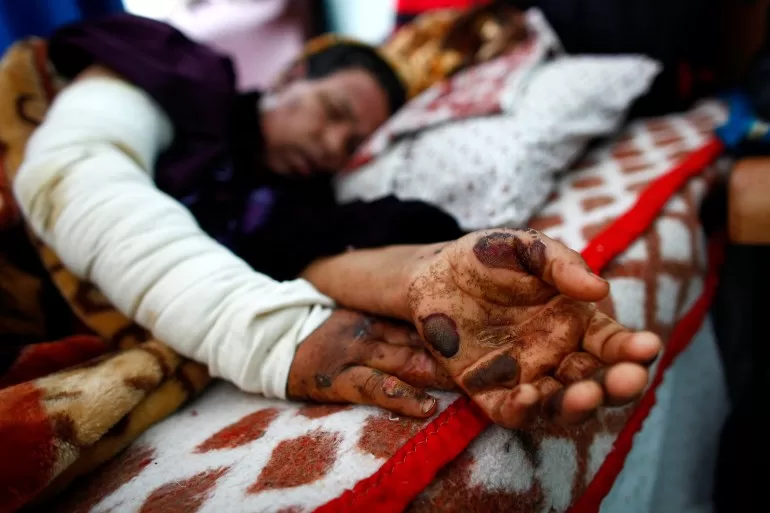A new report released Wednesday by Human Rights Watch (HRW) concurs, showing that white phosphorus attacks are “putting civilians at grave risk” and “contributing to displacement”.
More than 92,600 people have been displaced from their villages in south Lebanon since October 6, according to the International Organization for Migration.
“Israel’s use of airburst white phosphorus munitions in populated areas indiscriminately harms civilians and has led many to leave their homes,” Ramzi Kaiss, Lebanon researcher at HRW, said in the report.
‘Lucifer’s jaw’
In their investigation, HRW also verified the use of white phosphorus munitions by the Israeli military in at least 17 municipalities across south Lebanon since October 2023, when Israel’s war on Gaza began.
They verified the illegal use of airburst munitions over populated residential areas in the municipalities of Kfar Kila, Meiss el-Jabal, Boustane, Markaba and Aita al-Shaab.
White phosphorus injuries can be severely painful and necrotic. Oxides can reignite in the skin unless the burns are covered immediately and kept covered to prevent any exposure to oxygen.

Other symptoms may include severe respiratory problems, acute lung injury, severe eye damage, second or third-degree burns, or even severe bone diseases, such as the necrotic “Lucifer’s jaw”.
At least 173 people have been injured by exposure to white phosphorus between October and late May, according to Lebanon’s Ministry of Public Health.
Among those are verified cases of civilians who were rushed to a hospital on October 15 for asphyxiation after coming in contact with the phosphorus.
And reported cases of white phosphorus continued into June.
In a March investigation into Israeli use of white phosphorus in southern Lebanon, Al Jazeera was told by Lebanese experts that Israel was attempting to create a buffer zone by making the region uninhabitable and impossible to cultivate.
Agriculture accounts for up to 80 percent of south Lebanon’s gross domestic product (GDP), according to the United Nations.
Al Jazeera’s investigation found that Israel had dropped 117 phosphoric bombs on southern Lebanon, striking at least 32 towns and villages between October and March.
The impacted area spanned nearly the entirety of Lebanon’s 100km (62-mile) southern border.
Israel’s repeated use of white phosphorous has drawn the ire of international rights organisations. On March 19, Oxfam and HRW called on the Biden administration to “immediately suspend arms transfers to Israel.”
Loopholes on white phosphorous
The documented use of white phosphorus has renewed calls from rights organisations to close the loopholes that see it used in populated areas.
“Israel’s widespread use of white phosphorus in south Lebanon highlights the need for stronger international law on incendiary weapons,” the HRW report said.
The HRW report urged Lebanon to file a declaration with the International Criminal Court (ICC) to enable an investigation and prosecution “of grave international crimes…on Lebanese territory since October 2023”.
Neither Lebanon nor Israel are members of the ICC. The court would need a formal declaration from one of the parties to investigate.
Lebanon recently walked back an earlier statement that it would give the ICC jurisdiction to investigate Israeli war crimes on its territory post-October 7.
Lebanon’s caretaker government voted in April for the Ministry of Foreign Affairs to file such a declaration of jurisdiction.
When the decision was withdrawn, some analysts speculated that Lebanese parties feared an ICC investigation might also hold them liable.
Israel has a history of using white phosphorus in Lebanon, lending credence to the “buffer zone” theory, according to observers.

“The Israeli army targeted civilians with white phosphorus in the 1982 invasion and, since October 7, there has been a lot of white phosphorus used on forests, plantations, olive and fruit trees,” Mohammad Hussein, head of South Lebanon’s Agricultural Union, told Al Jazeera in March.
There were also documented uses of white phosphorus munition during Israel’s siege of western Beirut in 1982.
After rights groups accused Israel of war crimes for its use of white phosphorus in its 2008-09 Gaza offensive, the Israeli military said it would start using it as smokescreen munitions in built-up areas, with unspecified exceptions.
“Stronger international standards against the use of white phosphorus are needed to ensure these weapons do not continue to endanger civilians,” Kaiss said.
“Israel’s recent use of white phosphorus in Lebanon should motivate other countries to take immediate action toward this goal.”
